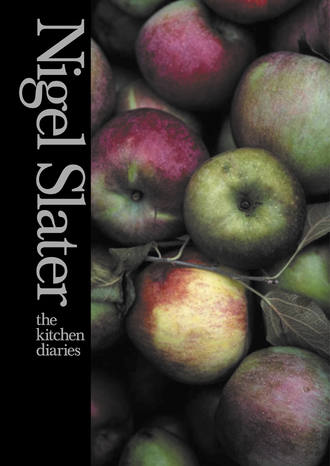
Полная версия
The Kitchen Diaries
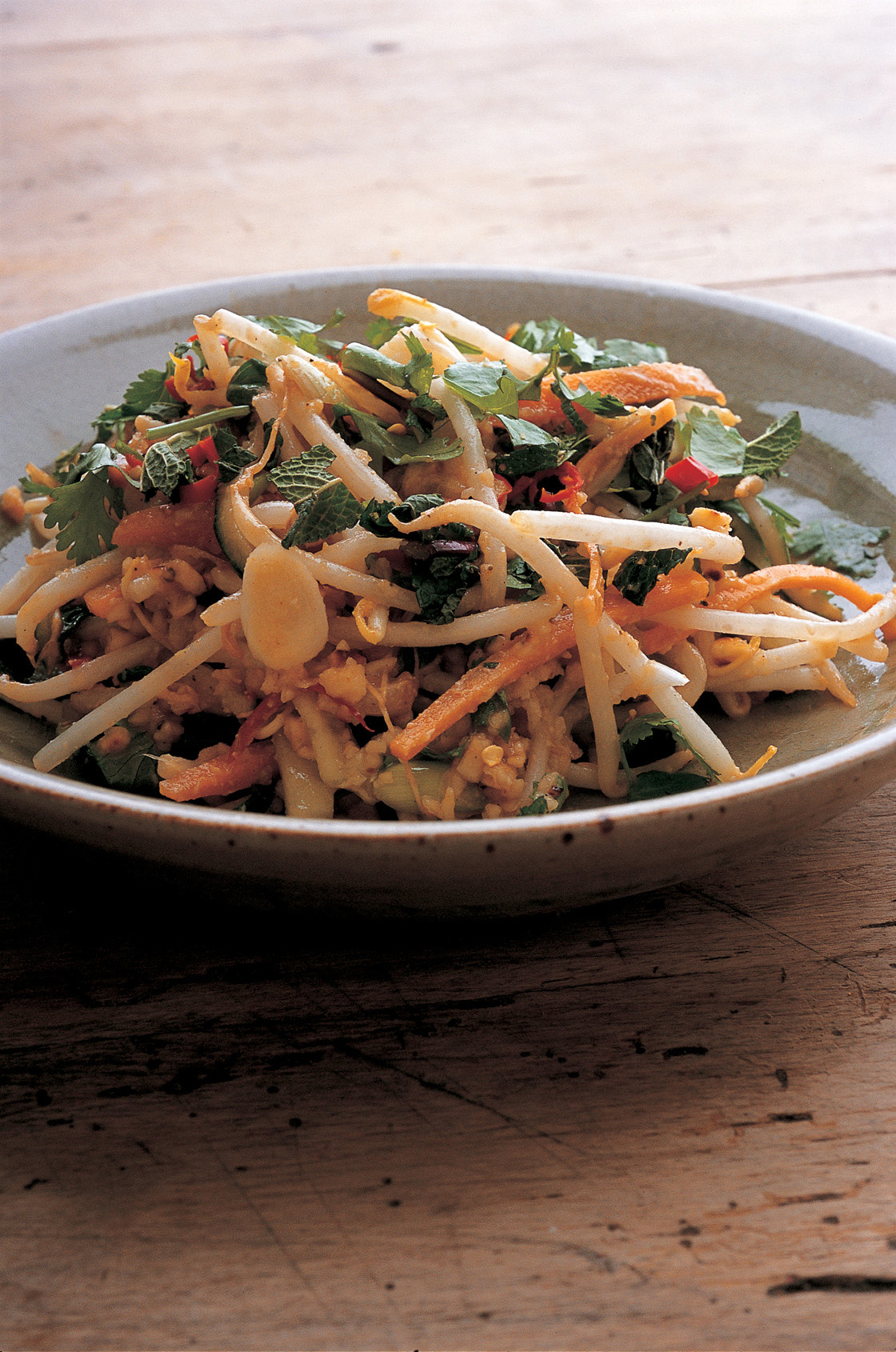
February 21
A slow roast
for a snowy
night
There is something romantic about falling snow. This is the first decent fall we have had this year, in two hours covering the box hedges and settling on the grey branches of the plum trees. By mid afternoon, with a single trail of fox prints to the kitchen door, the garden looks like a Christmas card. The cats, huddled together round the Aga, look as if they are not amused: ‘Oh, that stuff again.’
Every sound is muffled, the grass across the road sparkles in the streetlights, not a soul passes the front door. It is as if everyone is asleep. It takes something magical to make this stretch of road look as it does now, like a scene from a fairy tale. There is a leg of lamb in the fridge that I intended to roast as usual, with mint sauce and roast potatoes. With each windowpane edged in snow, I now want something more suited to a world white over. I put the leg into a deep cast-iron casserole with a rub of ground cumin, salt and thyme and let it bake slowly, occasionally basting its fat, as it turns a deep, glowing amber.
Slow-roast lamb with chickpea mash
a leg of lamb, about 2.3kg
For the spice rub:
garlic – 2 cloves
sea salt flakes – a tablespoon
a pinch of sweet paprika
cumin seeds – a tablespoon
thyme leaves – 2 tablespoons
olive oil – 2 tablespoons
butter – a thick slice
Set the oven at 160˚C/Gas 3. Make the spice rub: peel the garlic cloves, then lightly crush them with the salt, using a pestle and mortar. Mix in the sweet paprika, cumin seeds and thyme leaves. Gradually add the olive oil so that you end up with a thickish paste. Melt the butter in a small pan and stir it into the spice paste.
Put the lamb into a casserole or roasting tin and rub it all over with the spice paste, either with the back of a spoon or with your hands. Put it in the oven and leave for thirty-five minutes. Pour in 250ml of water and baste the lamb with the liquid, then continue roasting for three hours, basting the meat every hour with the juices that have collected in the bottom of the pan.
Remove the pan from the oven and pour off the top layer of oil, leaving the cloudy, herbal sediment in place. Cover the pan with a lid and set aside for ten minutes or so.
Carve the lamb, serving with the mashed chickpeas below, spooning the pan juices over both as you go.
Chickpea mash:
chickpeas – two 400g tins
a small onion
olive oil – 3–4 tablespoons
hot paprika
Drain the chickpeas and put them into a pan of lightly salted water. Bring to the boil, then turn down to a light simmer. You are doing this to warm the chickpeas rather than cook them any further. Peel and finely slice the onion, then let it soften with the olive oil in a pan over a moderate heat. This will seem like too much oil but bear with me. Let the onion colour a little, then stir in a pinch of hot paprika. Drain the chickpeas, then either mash them with a potato masher or, better I think, in a food processor. Mix in enough olive oil from the cooked onion to give a smooth and luxurious purée. Stir in the onion and serve with the roast lamb above.
Enough for 6.
February 22
Cold lamb, sliced thinly and tossed into a salad of tiny spinach leaves, Little Gem lettuce and baby red chard leaves. The whole thing looks pretty pedestrian until I add chopped fresh mint leaves to the olive oil and lemon dressing. Suddenly everything lights up. We eat it with bought focaccia and follow it with slices of commercial gingerbread spread with lemon curd.
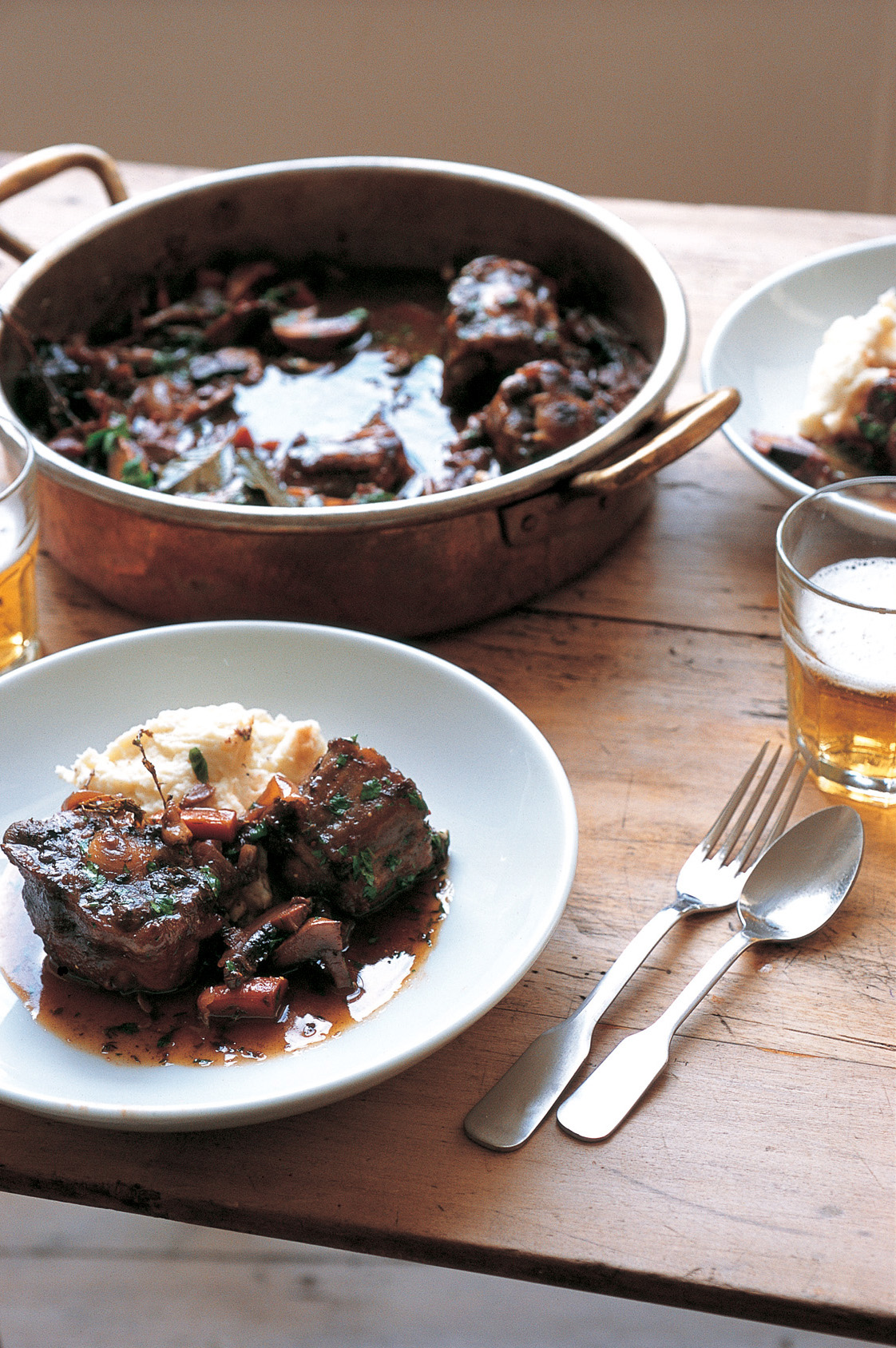
February 23
and 24
Bones and
gravy for an
icy day
There is still snow but it has turned to slush, the odd bit of ice taking you by surprise on your way to the shops. In ten minutes I manage to pick up an oxtail for tomorrow from the butcher, a bottle of wine, a few carrots and some mushrooms and even stop to pay the newspaper bill, which somehow I have let run into three figures. I feel as if I am eating too much meat this month, but squishy snow and ice means just one thing to me: gravy. Rich and thick with onions, gravy to fork into mounds of mashed potato, gravy to soothe and heal, to warm and satisfy. Gravy as your best friend.
Braised oxtail with mustard and mash
This is not a liquid stew, but one where the lumps of meat and bone are coated in a sticky, glossy gravy. Piles of creamy mashed potato, made on the sloppy side with the addition of hot milk, are an essential part of this.
a large oxtail, cut into joints
a little flour for dusting
ground chilli – a teaspoon
dry mustard powder – a heaped teaspoon
butter – a thick slice
a little oil, fat or dripping
onions – 2 large
winter carrots – 2 large
celery – 2 stalks
garlic – 4 large cloves
mushrooms – 5 large
tomato purée – 2 teaspoons
bay leaves – 4
thyme – a few bushy sprigs
a bottle of ballsy red wine, such as a Rioja
grain mustard – a tablespoon
smooth Dijon mustard – a tablespoon
a little parsley
creamy mashed potato, to serve
Set the oven at 150°C/Gas 2. Put the oxtail in a plastic or zip-lock bag with the flour, ground chilli, dry mustard powder and a good grinding of black pepper. Seal it and shake it gently until the oxtail is covered.
Warm the butter and a little oil, fat or dripping in a heavy-based casserole. Lower in the pieces of oxtail and let them colour on each side, turning them as they take on a nice, tasty bronze colour. Whilst the meat is browning, peel the onions and carrots and roughly chop them, then cut the celery into similar-sized pieces. Lift out the meat and set aside, then put the vegetables in the pot and let them colour lightly. Peel the garlic, slice it thinly, then add it to the vegetables, along with the mushrooms, each cut into six or eight pieces. Squeeze in the tomato purée. Continue cooking until the mushrooms have softened and lost some of their bulk.
Return the oxtail and any escaped juices to the pan, tuck in the bay and thyme, then pour in the red wine. Bring briefly to the boil, season lightly with salt and cover with a tight lid. Transfer the dish to the oven. You can now leave the whole thing alone for a good two hours. I’m not sure you even need to give it a stir, though I inevitably do half way through cooking. After an hour, check the meat for tenderness. I don’t think it should be actually falling off the bones but it certainly should come away from the bone easily when tugged. Depending on the oxtail, it could take as long as two or three hours in total. Set the oxtail aside to cool, then refrigerate, preferably overnight.
The next day, scrape off the fat that has set on the surface, then reheat the casserole slowly on the hot plate, stirring from time to time. Stir in the mustards. Once they are in, you should cook the stew for no longer than fifteen minutes, otherwise it will lose its edge. Stir in the parsley and serve with creamy mash.
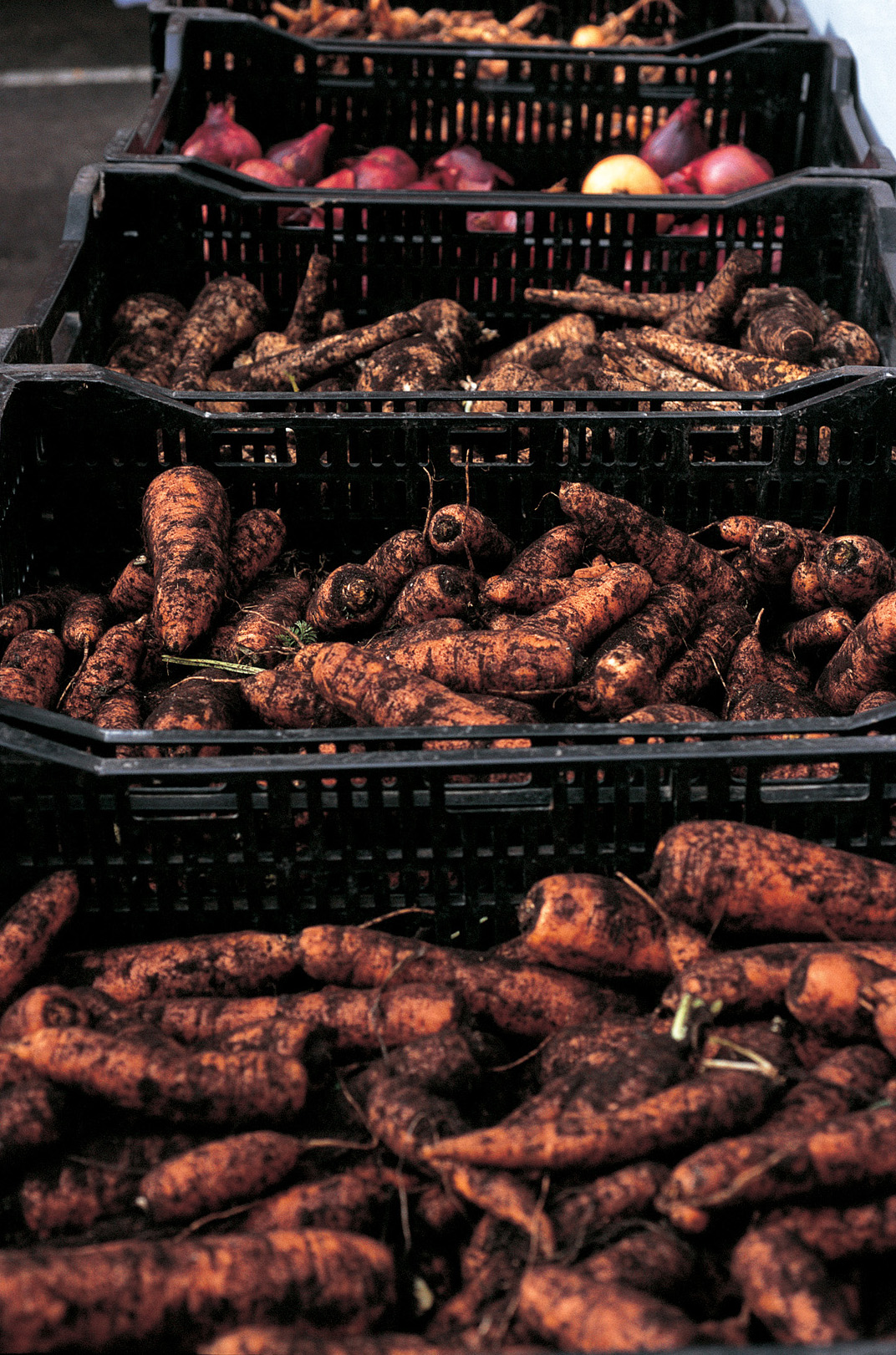
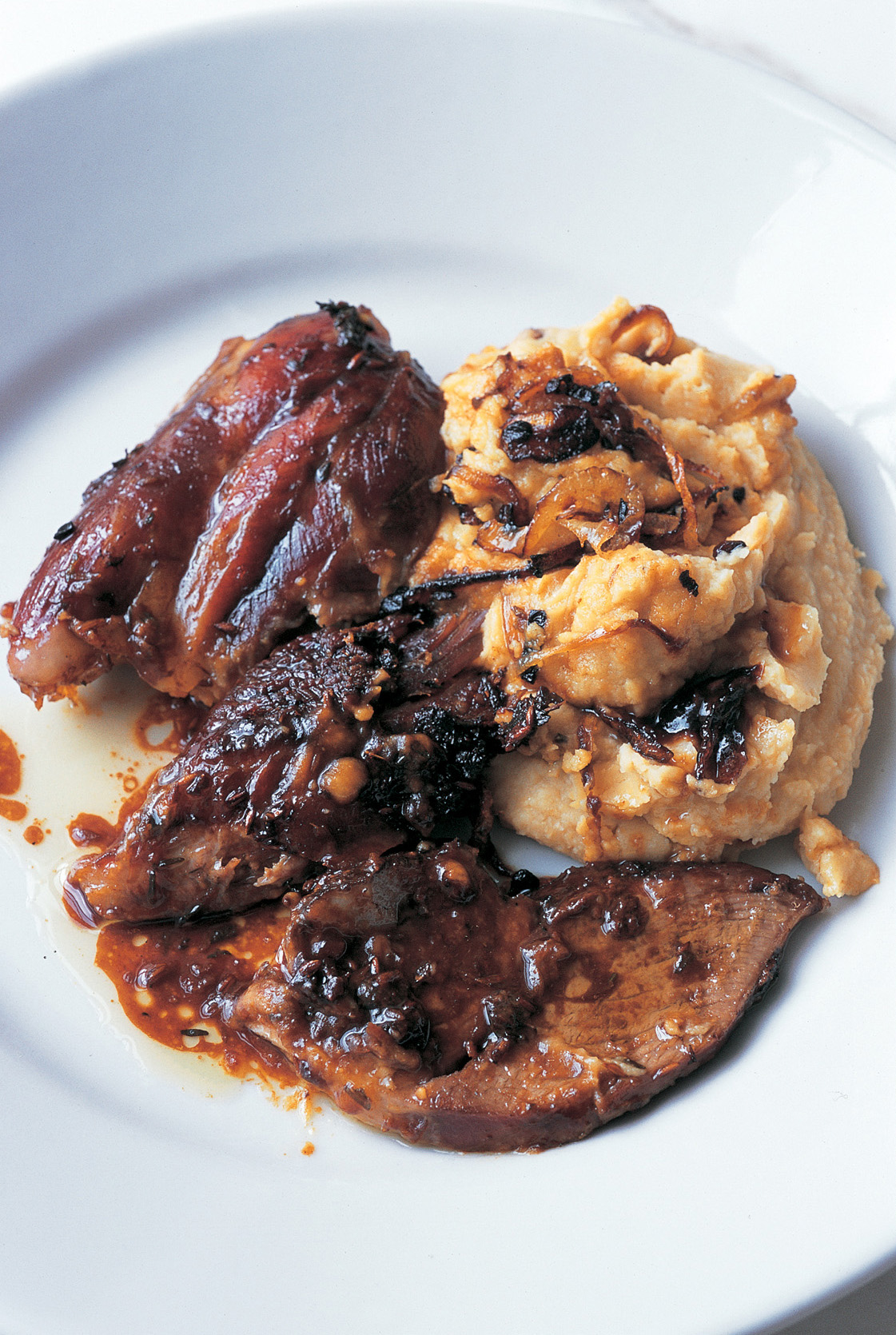
Treacle tart
You could call this a basic domestic version of treacle tart, but that would be to undersell it. No frills, none of the oozing unctuousness of a restaurant version, just a pleasingly frugal tart with crisp pastry and a thick golden filling. I do think cream in some form or another is essential here, and by the generous jugful too. You will need an old-fashioned shallow pie plate with sloping sides about 18cm diameter (across the base).
fresh, white bread – 220g
golden syrup – 8 heaped tablespoons (600g)
the juice of half a lemon
For the crust:
plain flour – 180g
butter – 90g
water – 2 tablespoons
Put the flour into a food processor with the cold butter cut into cubes and blitz until they resemble fine breadcrumbs. Pour in the cold water, blitz briefly, then tip the wet crumbs into a bowl. Bring the mixture together with your hands to form a ball. It will seem dry at first, but once you have squeezed and rolled the dough for a minute with your hands it will soften. Roll out on a lightly floured board to fit the tart tin.
Very lightly butter the tin, then lay the pastry over and push it carefully into the tin. Trim any overhanging pastry, then prick the base gently with a fork and put in the fridge to rest. Set the oven at 200°C/Gas 6.
After twenty minutes’ resting (the pastry that is, not you), remove the pastry from the fridge, place a piece of greaseproof paper over it, then cover it with baking beans or a similar-sized tart tin to stop it bubbling up. Bake for ten minutes. Remove the paper and beans and return the tin to the oven for ten minutes, until the surface of the pastry is dry to the touch.
While the case bakes, whiz the bread in a food processor till it is in fine crumbs, then tip them into the empty pastry bowl. Mix in the golden syrup and the lemon juice. Pour the mixture into the pastry case, turn the oven down to 180°C/Gas 4 and bake for thirty minutes. When it comes from the oven, leave the tart to rest for a good ten minutes, then serve with cream.
Enough for 6
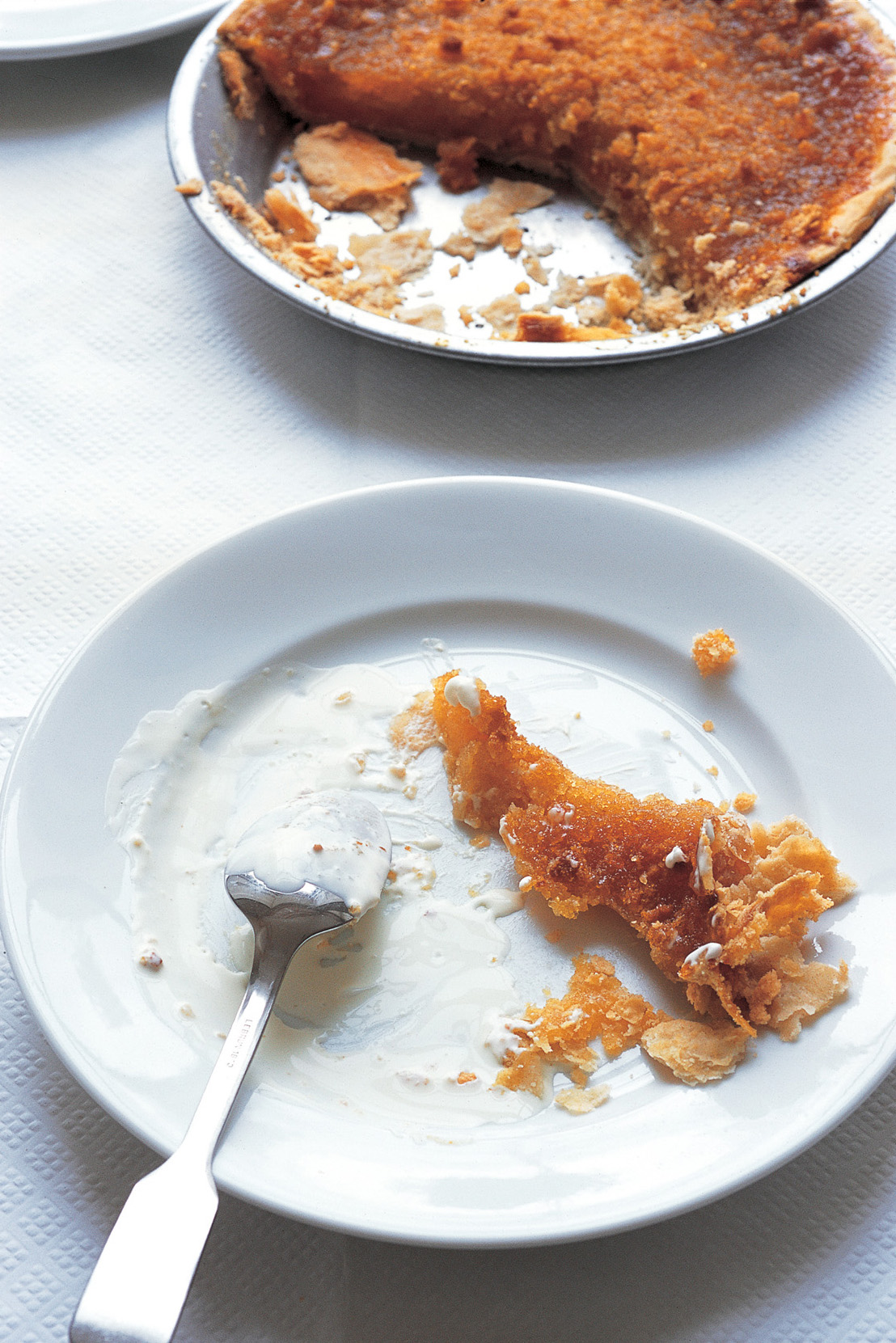
February 25
Grey skies
and piquant
flavours
After a row of rib-sticking suppers, I need something clean-tasting and sharp. Something to wake us up rather than make me nod off in front of the TV.
Anything cooked with vinegar, onions and northern European spices has always excited me. Juniper is something I can never get enough of, its clean ‘gin and tonic’ scent instantly invigorating a grey February soul.
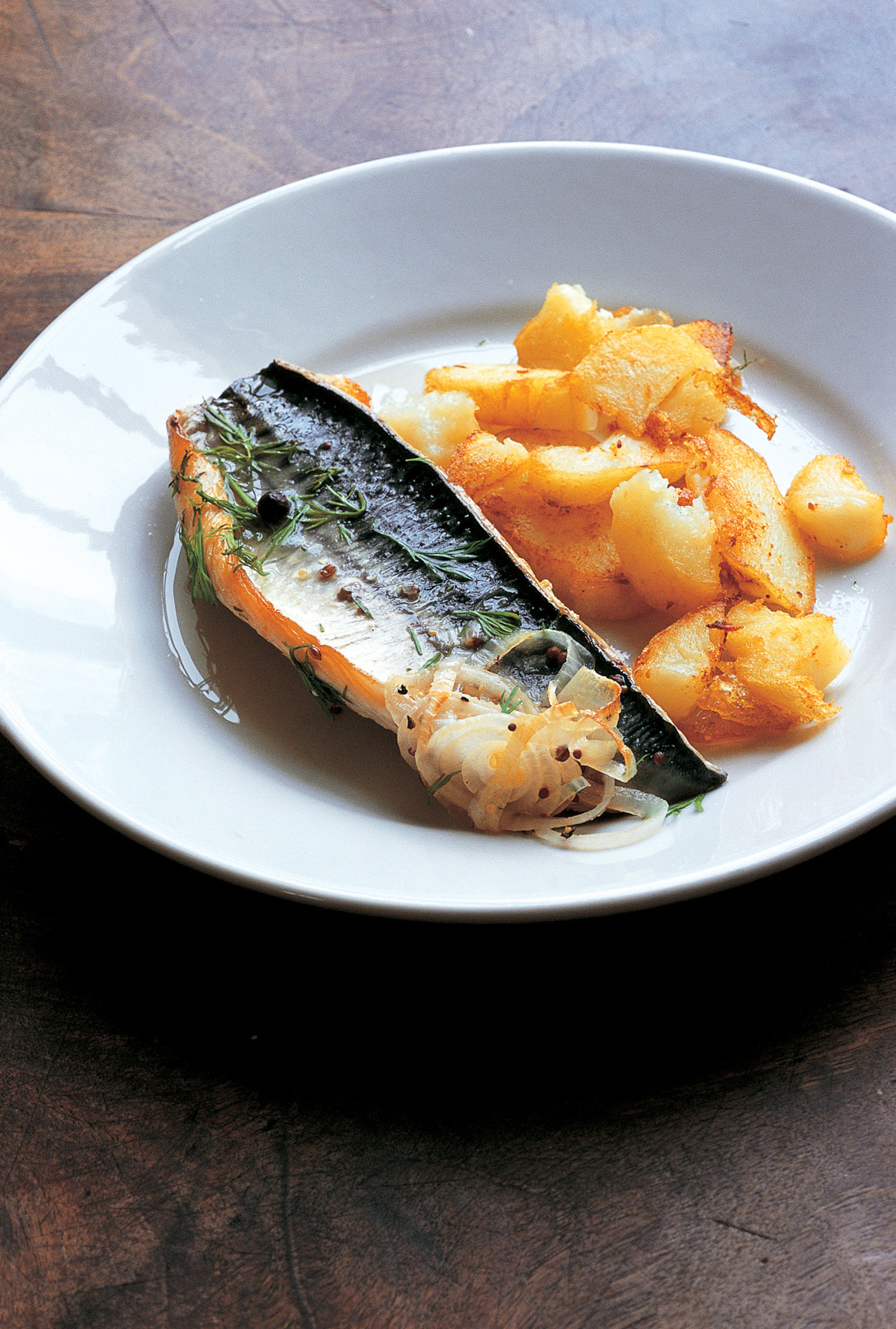
Warm soused mackerel
Piquancy is something I value in a fish recipe, especially when that fish is one of the oily varieties, such as tuna, herring or my favourite mackerel. It may sound a little strange but I recommend some sautéed potatoes with this.
mackerel – 3, filleted
a small onion
tarragon vinegar – 150ml
white vermouth or white wine – 50ml
juniper berries – 12, lightly crushed
mustard seeds – half a teaspoon
white peppercorns – 6
black peppercorns – 9
caster sugar – 2 tablespoons
bay leaves – 2
sautéed potatoes, to serve
Set the oven at 180°C/Gas 4. Rinse the mackerel fillets and lay them in a shallow ovenproof dish of china, glass or stainless steel (not aluminium). Peel and thinly slice the onion and put it into a non-corrosive saucepan, together with the vinegar and vermouth or wine. Then add the juniper berries, mustard seeds, white and black peppercorns, sugar, bay leaves and a good pinch of salt. Bring to the boil, then pour the mixture over the fish. Add enough water to just cover the fish – no more.
Cover the dish lightly with aluminium foil and bake for twenty minutes. Serve the fish warm, two fillets each, with sautéed potatoes.
Enough for 3

march
An English cheese salad
A simple flatbread
Taramasalata – the real thing
Chicken stew and mash
Pork burgers with lime leaves and coriander
A fiery way with lamb
Chicken salad with watercress, almonds and orange
Smoked mackerel on toast
Roast fillet of lamb with anchovy and mint
Demerara lemon cake with thick yoghurt
Prawn and coriander rolls
Chinese broccoli with oyster sauce and ginger
Chocolate almond cake
Stir-fried mushrooms, spring leaves and lemon grass
Chickpea and sweet potato curry
Orange jelly with lemon and cardamom
Chicken with mushrooms and lemon grass
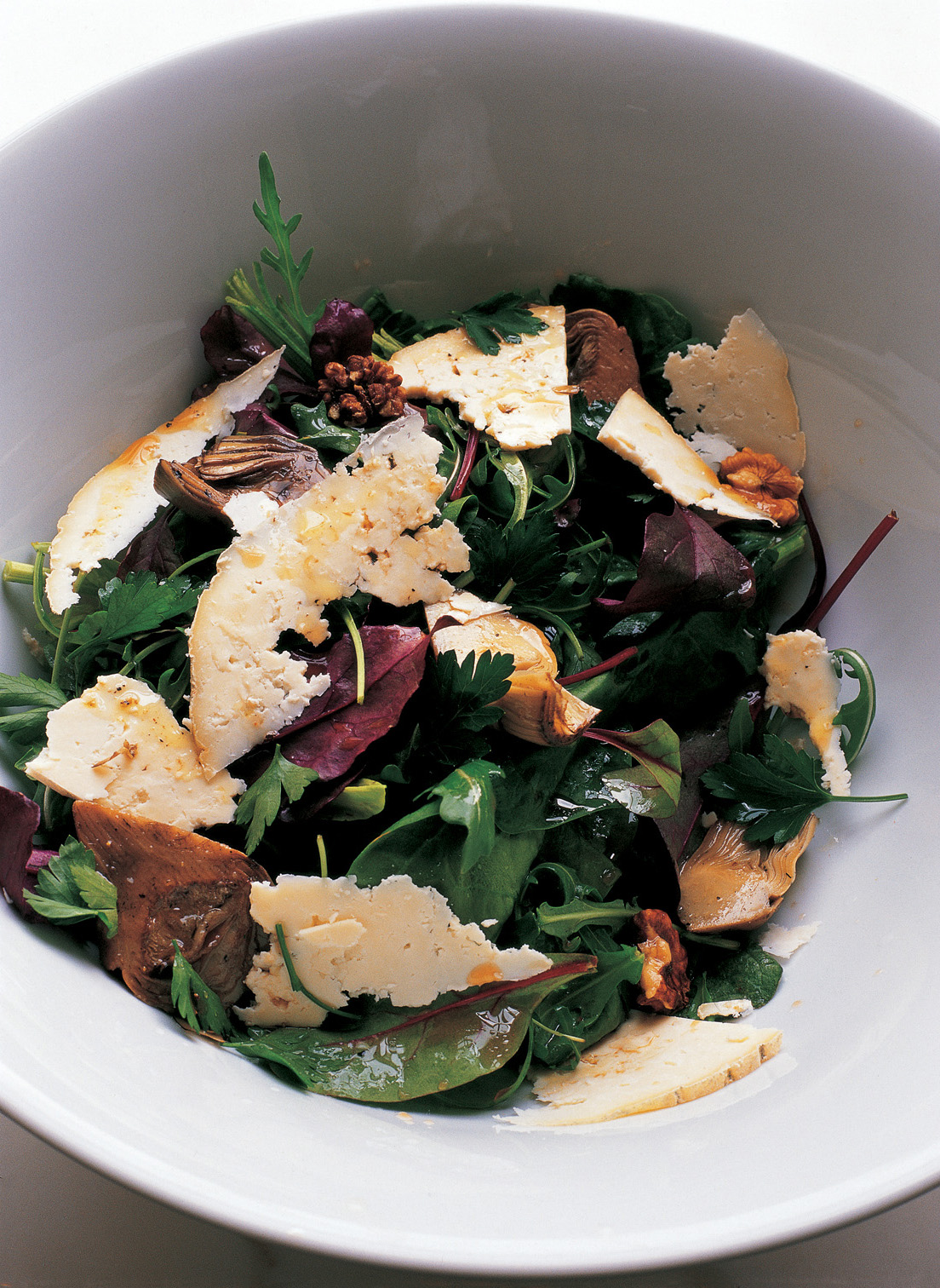
March 1
An English
cheese salad
It is a bit spooky the way the contents of those ‘pillow packs’ of salad from the supermarket somehow collapse and die within what seems like minutes of opening. Yet the mixed salad leaves you buy at the farmers’ market and the ones that come from the organic boxes last several days in the fridge. The bag of leaves I picked up from Marylebone farmers’ market – baby leaves of red chard, wild rocket, oak-leaf lettuce, spiky-leaved mizuna and crunchy little Cos – is still perfect three days after I brought it home. I toss the delicate leaves and their fragile stems with large shavings of young Wensleydale, toasted walnut halves, a bunch of large-leaved watercress and the merest dribble of walnut oil and lemon juice. A gentle, softly flavoured salad of unmistakable Englishness.
We follow this with a soup made from fat, old, woody carrots and vegetable bouillon, the root vegetables coarsely grated and then sweated with finely chopped onion in a very little butter. No cream, just the soup put in a blender till smooth, then chopped chives and a knob of butter stirred in at the end.
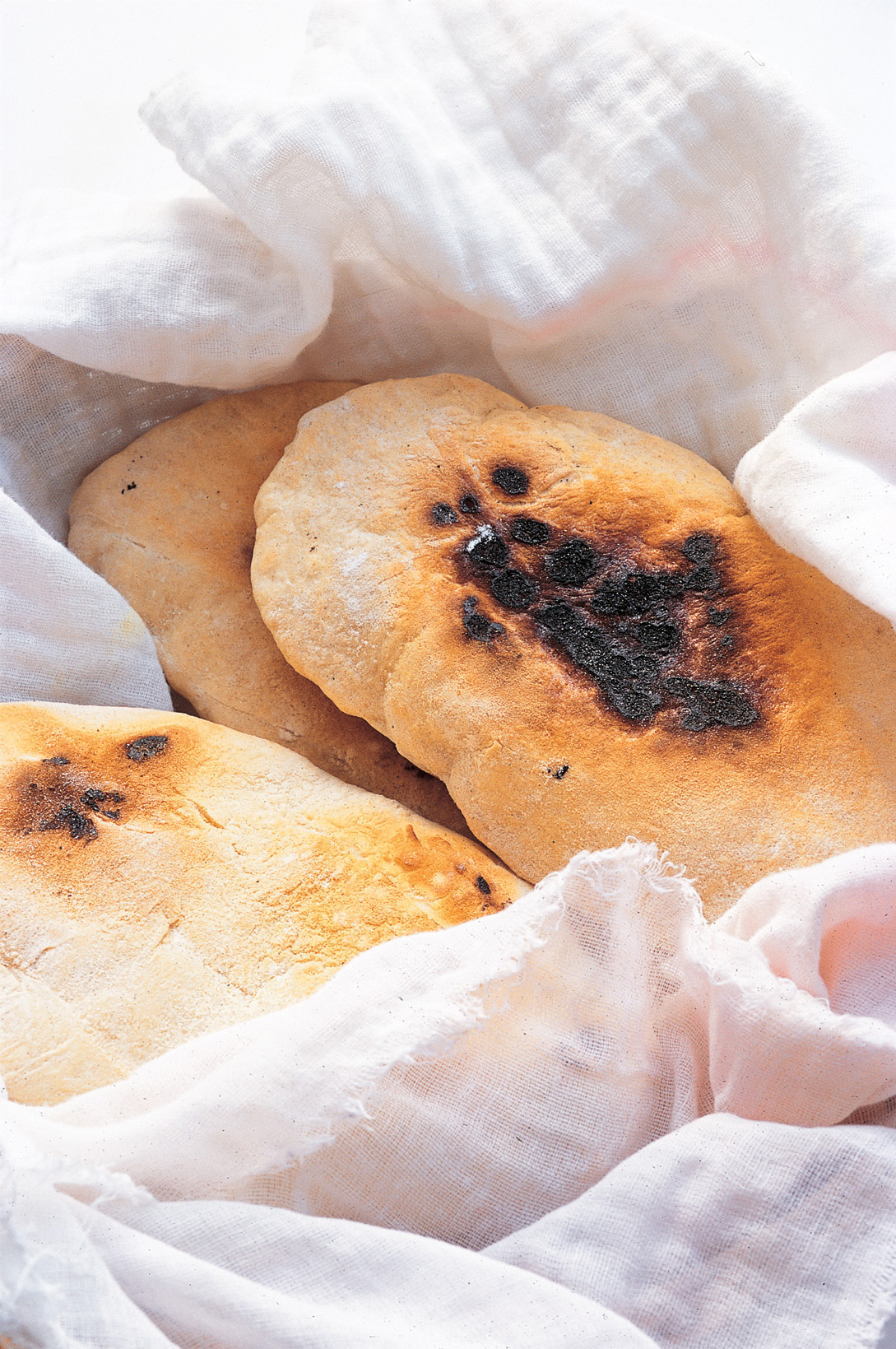
March 2
Flatbread and
a homemade
dip
Fat flakes of snow are pattering against the panes of the kitchen door, each one sticking on the glass for just a second before dissolving. It is cold enough to have frozen the water in the bucket on the back steps. If ever there was a day to bake bread, this is it. No gung-ho excitement here, just a gentle bit of bread making, the feel of warm, soft dough in the hands, the smell of a fresh loaf coming from the oven and always, always the feeling of ‘Why don’t I do this more often?’
I use dried yeast rather than fresh, simply because I can buy it in the local health-food shop. The flour is organic white from a small mill. Rather than a loaf, today I make slipper-shaped flatbreads to eat warm with taramasalata and hummus. I have never made hummus better than the stuff you can buy at the Green Valley, just off the Edgware Road. White-coated counter staff serve it by the big spoonful straight into a shallow plastic tray, then drizzle the parchment-coloured cream with emerald-green olive oil. But proper tarama is almost impossible to find, and shoppers seem to have accepted the bubblegum-pink stuff sold in tubs at the deli as the real thing. It isn’t. It’s crap. As commercially made food (mayonnaise, tomato soup, pesto) goes, it is the furthest from the real thing. Not even the merest shadow. So I draw a deep breath and pay a small fortune for real smoked cod’s roe from the fishmonger’s, a purple-veined, rusty-pink lobe of roe to beat into olive oil, a clove of garlic and perhaps a little bread to eke it out.
A simple flatbread
strong white flour – 500g
sea salt – half a teaspoon
dried yeast – a 7g sachet
warm water – 350ml
olive oil – 2 tablespoons
Put the flour into the bowl of a food mixer (you will need the beater attachment), then add the salt. If you are using a coarse salt, crumble it first between your finger and thumb. Empty the yeast into a small glass, pour on enough water to make a thin paste, then stir in the rest of the warm water. (This isn’t strictly necessary, you can put the dry yeast straight into the flour, but I prefer to do it this way.) Pour the water on to the flour and turn the mixer on slow. Introduce the olive oil, mixing till you have a stiffish dough. Tip the dough out on to a floured board and knead it with your hands, pushing and folding the dough until it feels springy and elastic to the touch. Set aside in a bowl covered with a clean tea towel and leave to rise for an hour or so. A warm place out of any draughts is ideal.
If you want to make the dough by hand, add the yeast and water to the flour and salt, mixing the two together with your hands or a wooden spoon. Mix in the olive oil – a pleasant, if squelchy, thing to do with your bare hands – then turn the lot on to a lightly floured work surface. Knead for a good nine or ten minutes, folding the far edge of the dough towards you and pushing it back into the dough. It should feel soft, springy and alive. Cover the dough with a clean tea towel as before and leave to rise.
Get the oven hot to 240°C/Gas 9. When your dough is about four times the size it was, break it into six pieces and push each one into a rough slipper shape. Dust them with flour and lie them flat on a baking sheet. Bake for five minutes, then turn the oven down to 220°C/Gas 7 and continue baking for a further five minutes or so, until the underside of the bread sounds hollow when you tap it.
Makes 6 small flatbreads
Taramasalata – the real thing
smoked cod’s roe – a 100g piece
white bread – 2 thick slices
garlic – a plump clove
olive oil – 200–300ml
the juice of a lemon
Peel the skin from the roe, or scoop the eggs out of the skin with a teaspoon. Soak the bread in water, then wring it out. Mash the bread into the roe with a pestle and mortar or in a food mixer. Add the clove of garlic, finely chopped, then the olive oil, pouring it in gradually as if you are making mayonnaise. When the mixture is a thick cream, stir in the lemon juice. Serve lightly chilled, with the warm flatbreads and some black olives.
Enough for 4
March 3
In my smug haze of good housekeeping from yesterday’s baking session, not to mention my arch disdain for factory-produced foods, I fail to notice there is bugger all to eat in the house. At seven-thirty I dash to the corner shop, returning with a tin of baked beans, a bag of oven chips and some beers.
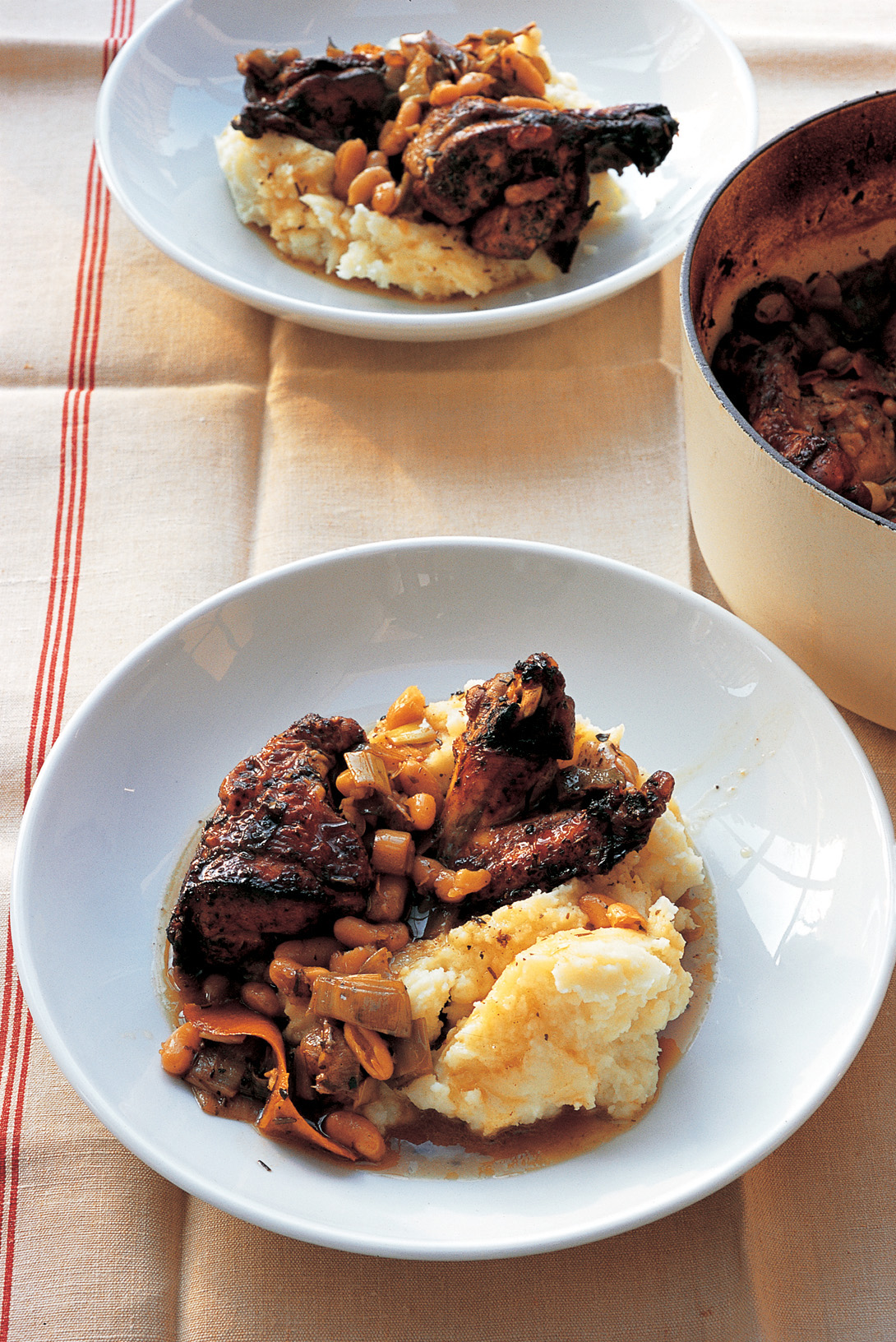
March 4
Snow and a
chicken
stew
Snow has fallen as I slept. I fold back the shutters and stare out at the garden without moving for a full ten minutes. Snow brings a hush, a softness, to the city that is all too brief. You have to make time for it. The gravel path, the spindly trees, the little hedges that frame the vegetable and fruit beds are white over. The kitchen itself is icy this morning, its light muffled by the snow that has built up on the skylights. Breakfast is porridge, made with water. No sugar, no treacle, no hot milk. Just rolled oats and water.
Shopping is usually slipped into other jobs and journeys: a dash into the greengrocer’s whilst I am on my way to a meeting; a trip to the fishmonger’s on my way home. But today’s shopping is thought out, with a list and a big bag. There are four of us for supper and it is still snowing. I am not going to get away with a salad and a slice of tart.
One of the advantages of my butcher’s free-range birds is that their bones are heavy and strong, as you would expect from something that has had the opportunity to exercise. The availability of these big birds and their fat, sauce-enriching bones makes it seriously worth thinking about chicken stew – a bird cooked slowly, with stock, herbs and aromatics. The results are mild but meaty, which is just what you want when the wind is cold enough to make your eyes water.
Starch is an essential accompaniment to stew – polenta, mashed roots, potatoes slipped into the pot. This time my stew has beans in it. There is quite a lot of juice, which, despite the beans, screams out to be poured over some mashed parsnip or potato, perhaps with some parsley and a dollop of mustard stirred in. Something for the coldest days of the year.
Chicken stew and mash
dried cannellini beans – 150g
a large chicken, jointed
olive oil – 50ml, plus more for frying
balsamic vinegar – 50ml
garlic – 4 plump cloves, peeled
bay leaves – 3 or 4
dried herbes de Provence – 1–2 teaspoons
the pared rind of a small orange
leeks – 3 medium, thickly sliced
mash, to serve
Soak the beans in cold water for three or four hours, though overnight will not hurt (the older your beans, the longer they will need). Bring them to the boil in unsalted water and boil them for forty minutes.
Put the chicken joints in a glass, china or steel dish. Pour over the olive oil and a couple of tablespoons of the balsamic vinegar, then tuck in the peeled garlic cloves and the bay leaves. Scatter over the herbes de Provence, a good grinding of pepper and salt and the strips of pared orange. Leave in a cool place, overnight if possible or at least for four or five hours.
Set the oven at 200°C/Gas 6. Heat enough olive oil to cover the bottom of a shallow pan (don’t be tempted to fry the chicken in the oil from the marinade; it will spit and pop because of the vinegar). Add the chicken pieces, shaking the marinade from each as you go, and let them fry till they are golden brown on each side. You may find it easier to do this in two batches. Transfer the browned meat to a deep casserole – one for which you have a lid. Drain the boiled beans and add them to the pot.
In the same oil, fry the leeks over a low heat, so that they soften rather than colour. Allowing a leek to brown will send it bitter. Now add the garlic from the marinade, then pour in the remaining marinade, the rest of the balsamic vinegar and about a litre of water. Don’t be tempted to use stock instead; it will make the dish too rich. Bring to the boil, season generously with salt, then pour this mixture over the chicken. Tuck in the bay leaves and orange from the marinade, then cover the casserole and put it in the preheated oven for two hours. Half way through cooking, check that the chicken is still submerged. Check for seasoning: it may need salt, it will need black pepper and you may feel it needs a little more balsamic vinegar. Serve steaming hot, with mash, letting the thick juices from the stew form pools in the mash.
March 5









